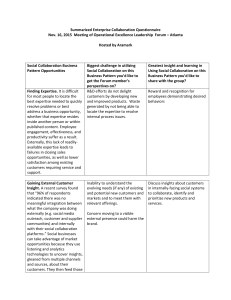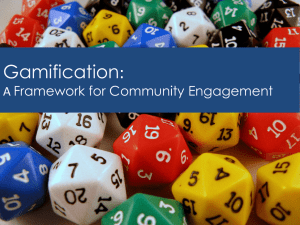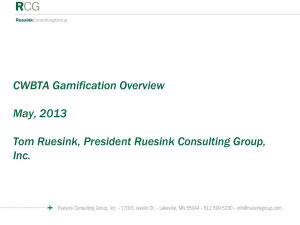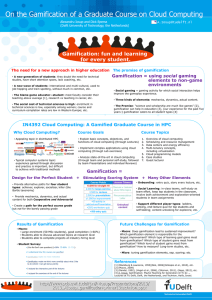Defining gamification: a service marketing perspective
advertisement
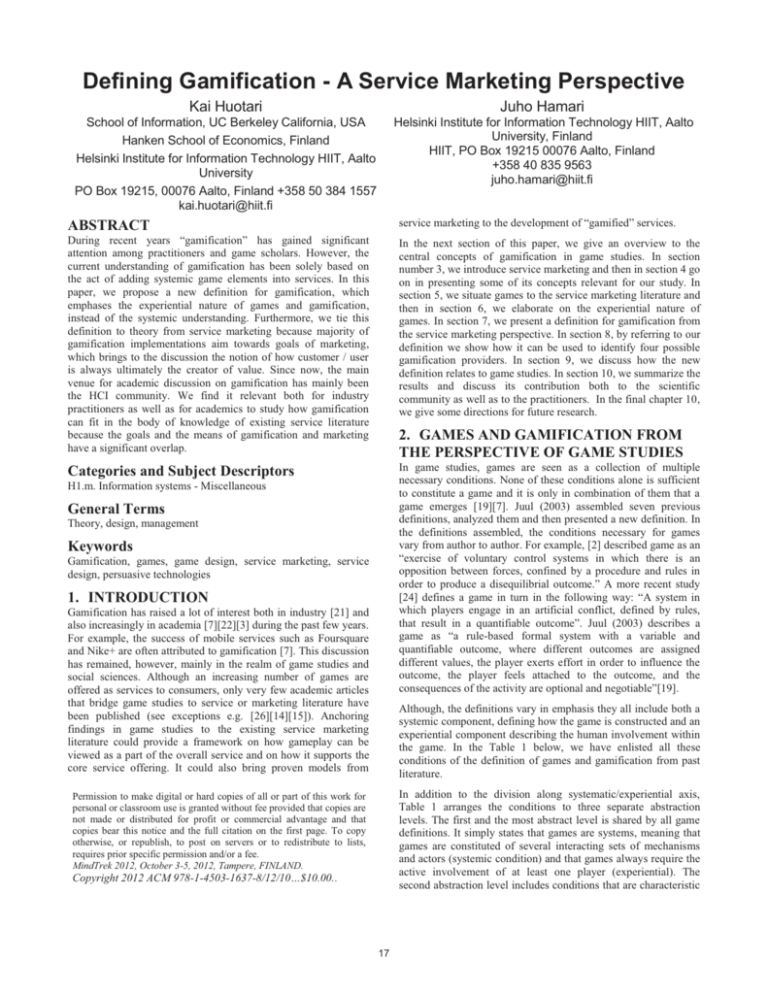
Defining Gamification - A Service Marketing Perspective Kai Huotari Juho Hamari School of Information, UC Berkeley California, USA Hanken School of Economics, Finland Helsinki Institute for Information Technology HIIT, Aalto University PO Box 19215, 00076 Aalto, Finland +358 50 384 1557 kai.huotari@hiit.fi Helsinki Institute for Information Technology HIIT, Aalto University, Finland HIIT, PO Box 19215 00076 Aalto, Finland +358 40 835 9563 juho.hamari@hiit.fi ABSTRACT service marketing to the development of “gamified” services. During recent years “gamification” has gained significant attention among practitioners and game scholars. However, the current understanding of gamification has been solely based on the act of adding systemic game elements into services. In this paper, we propose a new definition for gamification, which emphases the experiential nature of games and gamification, instead of the systemic understanding. Furthermore, we tie this definition to theory from service marketing because majority of gamification implementations aim towards goals of marketing, which brings to the discussion the notion of how customer / user is always ultimately the creator of value. Since now, the main venue for academic discussion on gamification has mainly been the HCI community. We find it relevant both for industry practitioners as well as for academics to study how gamification can fit in the body of knowledge of existing service literature because the goals and the means of gamification and marketing have a significant overlap. In the next section of this paper, we give an overview to the central concepts of gamification in game studies. In section number 3, we introduce service marketing and then in section 4 go on in presenting some of its concepts relevant for our study. In section 5, we situate games to the service marketing literature and then in section 6, we elaborate on the experiential nature of games. In section 7, we present a definition for gamification from the service marketing perspective. In section 8, by referring to our definition we show how it can be used to identify four possible gamification providers. In section 9, we discuss how the new definition relates to game studies. In section 10, we summarize the results and discuss its contribution both to the scientific community as well as to the practitioners. In the final chapter 10, we give some directions for future research. 2. GAMES AND GAMIFICATION FROM THE PERSPECTIVE OF GAME STUDIES In game studies, games are seen as a collection of multiple necessary conditions. None of these conditions alone is sufficient to constitute a game and it is only in combination of them that a game emerges [19][7]. Juul (2003) assembled seven previous definitions, analyzed them and then presented a new definition. In the definitions assembled, the conditions necessary for games vary from author to author. For example, [2] described game as an “exercise of voluntary control systems in which there is an opposition between forces, confined by a procedure and rules in order to produce a disequilibrial outcome.” A more recent study [24] defines a game in turn in the following way: “A system in which players engage in an artificial conflict, defined by rules, that result in a quantifiable outcome”. Juul (2003) describes a game as “a rule-based formal system with a variable and quantifiable outcome, where different outcomes are assigned different values, the player exerts effort in order to influence the outcome, the player feels attached to the outcome, and the consequences of the activity are optional and negotiable”[19]. Categories and Subject Descriptors H1.m. Information systems - Miscellaneous General Terms Theory, design, management Keywords Gamification, games, game design, service marketing, service design, persuasive technologies 1. INTRODUCTION Gamification has raised a lot of interest both in industry [21] and also increasingly in academia [7][22][3] during the past few years. For example, the success of mobile services such as Foursquare and Nike+ are often attributed to gamification [7]. This discussion has remained, however, mainly in the realm of game studies and social sciences. Although an increasing number of games are offered as services to consumers, only very few academic articles that bridge game studies to service or marketing literature have been published (see exceptions e.g. [26][14][15]). Anchoring findings in game studies to the existing service marketing literature could provide a framework on how gameplay can be viewed as a part of the overall service and on how it supports the core service offering. It could also bring proven models from Although, the definitions vary in emphasis they all include both a systemic component, defining how the game is constructed and an experiential component describing the human involvement within the game. In the Table 1 below, we have enlisted all these conditions of the definition of games and gamification from past literature. In addition to the division along systematic/experiential axis, Table 1 arranges the conditions to three separate abstraction levels. The first and the most abstract level is shared by all game definitions. It simply states that games are systems, meaning that games are constituted of several interacting sets of mechanisms and actors (systemic condition) and that games always require the active involvement of at least one player (experiential). The second abstraction level includes conditions that are characteristic Permission to make digital or hard copies of all or part of this work for personal or classroom use is granted without fee provided that copies are not made or distributed for profit or commercial advantage and that copies bear this notice and the full citation on the first page. To copy otherwise, or republish, to post on servers or to redistribute to lists, requires prior specific permission and/or a fee. MindTrek 2012, October 3-5, 2012, Tampere, FINLAND. Copyright 2012 ACM 978-1-4503-1637-8/12/10…$10.00.. 17 to games, but are not necessarily present in all games. Under this category fall such systemic conditions as rules, conflicting goals and uncertain outcomes. Deterding et al. (2011) labels these conditions game design elements [7]. Level 2 experiential outcomes are hedonic experiences, suspense (that results from player valuing outcomes but being uncertain of them) and gamefulness. Also mastery and competence stated by [23] could be included in this category. The third abstraction level should include conditions that are unique to games. However, this level remains empty in the light of past literature defining games. There does not seem to be elements that were solely unique to games. games, their definition of gamification adopts only a systemic perspective to games. We argue that this approach has several shortcomings and we will discuss them in section 6. In order to give context to our arguments, let us first turn to service marketing literature: its origins and some of its key concepts. 3. EMERGENCE OF SERVICE MARKETING In the late 1970’s and early 1980’s, a handful of marketing scholars started forming a new school of thought for marketing concentrating on services because the classical marketing axioms were based on the exchange of physical goods, which could not provide a sufficient understanding on services [13]. This line of research developed quite independently of the mainstream marketing science until the 1990’s [12] when it started to gain popularity also outside the sphere of service marketing scholars. Marketing theory build to fit services started to seem applicable also for goods marketing. In 2004, [31] launched the term servicedominant (S-D) logic for marketing and proclaimed that the service approach should replace the classical marketing theory. Since then, the S-D logic for marketing has gained growing interest both in academia as well as in industry. Table 1: Game conditions Level of abstraction Systemic conditions Experiential 1 level (common to all games) Games are system (1, 2, 3, 4, 5, 6, 7, 8, 9) Games require voluntary involvement of players/users (1, 2, 3, 4, 5, 6, 7, 8, 9) 2nd level (characteristic to games, although not necessarily to all games) - Rules (1, 2, 4, 5, 6, 7, 8, 9) - Generates hedonic pleasure (2, 4, 5, 6) Conflicting goals (1, 3, 4, 6, 7, 8, 9) - Generates suspense (4, 6) st - Variable and uncertain outcomes (1, 2, 4, 6, 7, 8) 3rd level games) (unique to -? conditions Two key concepts of the service approach, customer as coproducer and value-in-use, help to explain the ubiquitous applicability of the service logic and the profound difference between the traditional, goods-dominant logic and the new service-dominant logic. - Generates gamefulness (4) In traditional marketing theory, the production is considered to be carried out by the company and value is considered to be created during the production process by the company and to be embedded in the resulting product. The product then “carries” the value in it and the value is transferred from company to the customer with the transaction. In service context however, this value-in-exchange approach becomes meaningless, as there is no physical product to which the value could be attached. -? Referred articles: 1.[2]; 2. [4]; 3.[5]; 4.[7]; 5. [17]; 6.[19]; 7. [20]; 8. [24]; 9. [27] The lack of systemic conditions unique to games is not surprising, as [19] and [7] have stated that a game emerges only as a combination of conditions and that none of the conditions alone is sufficient in constituting a game. However, it is surprising that none of the definitions describe an experiential condition unique to games. If this would be the case, how would anyone recognize a game? Or to put the question in [19]’s and [7]’s words, how would anyone know when a game has emerged from a combination of different necessary conditions if it were not for an experiential condition unique to games? The term ‘gamefulness’ could be used to describe such a unique condition, just like McGonigal [28] has suggested. Yet, [7] make a distinction between games and gamified services and state that both can lead to gameful experiences, thus rendering gamefulness a condition that is not unique to games. However, we think this is up for debate. Service marketing literature sees the customer always as a coproducer of the service, i.e. participating in the production process as the value is generated only once the customer uses the service or the good. In this value-in-use model company’s role in the value creation is to support the customers’ processes by offering resources into them. Resources can refer e.g. to personnel, machinery, service setting, or to available information sources. Furthermore, the value is considered to be experienced and determined by the beneficiary phenomenologically [32]. 4. SERVICE, SERVICE SYSTEM AND SERVICE PACKAGE For the purpose of defining gamification, three key concepts of service marketing need to be defined: service, service system and service package. The term ‘Gameification’ was first used in 2008 in a blog post by Brett Terill [29]. He described the term as ‘taking game mechanics and applying them to other web properties to increase engagement.’ To a more widespread industry use the term became during 2010 in its current form ‘gamification’ [7]. Vargo and Lusch [31] define service as “the application of specialized competences (knowledge and skills), through deeds, processes, and performances for the benefit of another entity or the entity itself”. Thus, any intentional act - no matter how small that helps an entity can be considered a service. In spite of the attention the term received quickly in the industry, the academia has been slow to react. To our knowledge there are only two definitions for gamification: the one given by Deterding et al. [7] and the one presented in the first short version and now a drastically different version of this paper. Deterding et al. [7] describe gamification as the use of game design elements in nongame contexts. While [7] discuss the experiential aspects of A systematic bundle of services constitutes a service system that, according to [25], “is an arrangements of resources (including people, technology, information, etc.) connected to other systems by value propositions”. A service system’s aim is to use its resources and the resources of others to improve its circumstance and that of others [33]. 18 The service package model [13] in turn helps firms manage bundled services or service systems. The basic service package consists of the core service, enabling services and enhancing services. Enabling services are required in the offering of the core service, while enhancing services support the offering of the core service and thus increase its value or differentiate it from competitors’ services. Thinking what is a ‘full-fledged game’ and what is not will only lead the designers astray from what should be their focus: customer/user/player experience. These incompatibilities led us to seek for an alternative way to define gamification from the perspective of service marketing. 7. A PROPOSED DEFINITION FOR GAMIFICATION 5. GAMES AS SERVICE SYSTEMS Based on the literature presented above, we define gamification in the following way: As the previous section demonstrates, there are a lot of complementarities between the game literature and service marketing theory. Seen through the service marketing literature, game design elements can be described as services and games as service systems. This is supported by table 1 that shows that games are always regarded as systems that require an active involvement by the player. Gamification refers to: a process of enhancing a service with affordances for gameful experiences in order to support user's overall value creation. We would like to emphasize that the definition highlights the goal of gamification - the experiences that it attempt to give rise to rather than the methods. Past definitions rely on the notion that gamification is based on the use of game elements. However, there doesn’t seem to exist a clearly defined set of game elements which would be strictly unique to games, neither they automatically create gameful experiences. We can find similar elements from a variety of non-game contexts as well. If we subscribed to the idea that game elements create a game or gamify a system, then we could conclude that also stock exchange dashboard, decision support systems, loyalty programs and other services that have for example levels, points and progression metrics would also be games, regardless of the subjective experiences the users have. Furthermore, gamification is not always carried out through any concrete elements alone. Therefore, we argue that the definition of gamification (nor games) cannot be based on a set of methods or mechanics, but instead it has to be understood more broadly as a process in which the gamifier is attempting to increase the likelihood for the gameful experiences to emerge by imbuing the service with affordances for that purpose (be it badges or more implicit cues). The term affordance here can refer to any qualities of the service system that contributes [11] to the emergence of gameful experience. Games are thus co-produced by the game developer and the player(s). The game developer’s part of the co-production takes place when the game’s storyline is created, rules invented, game design patterns chosen and visuals designed etc. The player(s)’s part of the co-production and of the value-creation takes place each time the game is played or otherwise interacted with. The game can also be solely or partly developed by the player, of course. The core service of the game is to provide hedonic, challenging and suspenseful experiences for the player(s) [21] or gameful experiences [22]. The quality of such a “game service” is strongly determined by the functional quality of the service or game experience, which is often referred to as flow [6]. 6. SUBJECTIVE NATURE OF THE EXPERIENCED VALUE OF A GAME It is noteworthy that from the service marketing perspective, it is always only the player’s participation in the game, i.e. playing the game, that completes the production of the game service. This notion is consistent with the definitions of games presented in chapter 2 that see player’s voluntary commitment and participation as one key building block of a game. However, according to the service marketing theory, the value of a service is determined solely by customer’s subjective experience, as service providers can make only value propositions. What follows is that value of a game service, be it ‘pleasure’, ‘suspense’, ‘mastery’ or ‘gamefulness’, is always determined by the player’s individual perception. In other words, it is possible that the use of a game service leads to gameful experiences with one user but does not do so with another user. This difference in outcomes may be due, for example, to differences in skills of the two users/players (see e.g. [30]). Another aspect we would like to highlight is that the definition does not imply that the process of gamification has to be successful. In the same way as game services or products, gamification can only attempt to support the user in creating gameful experiences. Currently, it seems that the successfulness of gamification has mostly been measured through sales figures, “clicks” and general retention of users. However, if we accept that gamification aims to create “gameful” experiences, then the successfulness of gamification should also be measured through same measurement instruments as games are. The experience of playing a game as well as determining what is a game is deeply individual. Thus, in our view, a game emerges only when the use of the service results in a gameful experience. What follows is that we see gamefulness as a unique experiential condition to games. This notion also leads to another point that gives boundary conditions to gamification. If gamification is designed solely to increase figures related to marketing instead of gameful experiences, the designers are in danger to fall into a trap that leads to a conflicting situation between selling and creating valuable experiences. One of the defining aspects of gameful experience is that it is voluntary and that it is carried out by having intrinsic motivation. If, however, the designer attempts to direct player/customers decision making in a way that it reduces the player/user’s free choice, then the design moves further away from what is in the core of a gameful experience. With ‘gameful experience’ we refer to an experience leading to ‘gamefulness’ an experiential condition unique to games. However, defining This greatly differs from the gamification definition proposed by [7], which highlights that only non-games can be gamified. The obvious question is: How can a service designer possibly identify a non-game context, when the existence of game is dependent on the subjective perception of the player/user. If the sensation of gamefulness is not unique to games this question becomes impossible to answer even for individual consumers. For example, a stock market and dashboard for participating in it can easily be perceived as creating gameful experiences for some users although it is not generally perceived as a game by all users. 19 exactly what "gamefulness" means is outside the scope of this paper, as defining "gamefulness" would also require us to define games themselves. third party service provider 3) The customer him/herself 4) Another customer. The enhanced service is provided either by one of these four parties or by a combination of them. Table 3 presents examples of gamified services with different gamification providers. The word ‘enhancement’ in the definition refers to the service package concept of service marketing literature introduced in the section 4. It entails that gamification describes a service system where a core service is enhanced by another one. From marketing perspective it is essential to make this distinction. Table 3: Examples of gamified services with different gamification providers According to the definition, Foursquare, for example, is not a gamified service in itself, but it can potentially gamify, that is, enhance other services, such as restaurants or bars, through rules, goal setting, variable outcomes, feedback and rewards. Moreover, the definition remains agnostic to the nature of the core service. This means that the core service can also be a game that can be further gamified, creating so-called meta games. From this perspective, it is not only non-games that can be gamified. Table 2: Examples of gamification Core service Enhancing service Gamified service Gamification provider Clothing store Loyalty program offered through Facebook deals [8] Customers who check in regularly using Facebook Places are offered reductions. Clothing store (core service provider) and Facebook Restaurant (e.g. Starbucks) Local Badges in Foursquare Customers who check in at least three times a week to a same location using Foursquare get a badge. Foursquare third party) (a Core service Enhancing service Gamified service Profile in LinkedIn Progress bar for measuring progress in filling personal details The enhancing service increases the perceived value of filling all details by invoking progress-related psychological biases. Sports bar Drinking game [34] Deciding to incorporate a drinking game to watching hockey, for example. Customer himself/herself Café Mayorship competition Foursquare The enhancing service creates a competition between customers where they have to visit the café frequently enough -> retention Coffee house Tip offered through Foursquare [9] Adding a questlike tip to other customers while they are waiting coffee. Another customer and Foursquare 9. CONCLUSION AND DISCUSSION in Dry cleaner Loyalty stamp card. You get 1 stamp for every visit The enhancing service invokes the psychological biases related to progress and thus increases the perceived value of using the same dry cleaner service. Gym Heya Heya Gym experience that sets goals and helps to monitor the progress of the training. Game study literature and service marketing literature are for large parts complementary. However, the previously proposed definition of gamification by Deterding et al. [7] adopts a systemic approach, which seems incompatible with the understanding of value creation in service literature which, in contrast, emphasizes the experiential nature of services. In this paper, we have defined gamification from the perspective of service marketing as ‘a process of enhancing a service with affordances for gameful experiences in order to support user’s overall value creation. This anchoring of gamification into an existing body of knowledge of service marketing and its concepts like ‘service package’, ‘value-in-use’ and ‘service systems’ will help subsequent research to examine how gamification can contribute to marketing sciences. It also provides the gamification research with proven theoretical models to build upon. The proposed definition is agnostic regarding the nature of the core service that is being gamified. Thus, it challenges the view that gamification can only happen when game-like elements are used in non-gaming contexts. It is important also to notice that according to this definition not all service systems combining games and other services involve gamification, as it is essential that the enhancing service supports the core service, not the other way around. For example, if a geocaching [10] game brings a customer to a public park, gamification has not occurred, as the core service is the geocaching game. In contrast, gamification occurs if the public park offers a geocaching game to its visitors. After the fact, it may be difficult to make the distinction between the core service and the enhancing service. Theoretically it is the customer’s subjective perception that determines what should be considered as the core service. However before the fact, it is the gamification provider’s perception that is decisive as it is the gamification provider who decides which service to gamify. Let us now, look how by referring to our definition of gamification we can identify gamification providers. Using the proposed definition, we have also identified four possible gamification providers. This will help service providers when designing the gamification of their service. One interesting line for future research could be the investigation of customer loyalty cards and other widely used marketing techniques as gamified services. Gamification could also be used to expand the servicescape model presented by Bitner in 1992, from physical settings to more abstract constructions, as [1] have suggested. Servicescape gives a framework for the landscape where the service takes place and that is under the control of the 8. FOUR POSSIBLE GAMIFICATION PROVIDERS It is not always the provider of the core service that also provides the gamification process. Based on our definition, we can identify four possible gamification providers, i.e. providers of the enhancing service. These are 1) The core service provider, 2) A 20 service provider [13]. Servicescape affects customers’ behaviour and perceptions. An example of servicescape could be the layout of an IKEA store. The layout design forces the customers on a certain path that present numerous temptations to them. Gamification could be used to enhance the experiential dimensions of servicescape that lead customers to gameful paths through the service process. 2011 Conference: Think Design Play, Hilversum, Netherlands, September 14-17, 2011. [17] Huizinga, Johan. (1944) Homo Ludens. The Beacon Press, Boston, 1950 (1944). [18] Huotari, K., and Hamari, J. (2011). "Gamification” from the perspective of service marketing. Proc. CHI 2011 Workshop Gamification (2011). 10. ACKNOWLEDGMENTS We would like to thank the participants of CHI 2011 Gamification Workshop for the valuable feedback that we received concerning the early ideas presented in the early draft of this paper [18]. [19] Juul, J. (2003). The game, the player, the world: Looking for a heart of gameness. M. Copier and J. Raessens (eds). Proceedings of Level-Up: Digital games research conference. Utrecht. University of Utrecht: 30-45. 11. REFERENCES [20] Kelley, David. The Art of Reasoning. W. W. Norton & Company, New York, 1988. [1] Arnould, E. J., Price, L. L. and Malshe, A. (2006). Toward a Cultural Resource-Based Theory of the Customer. In The Service-Dominant Logic of Marketing: Dialog, Debate and Directions, 320-33. [21] Kim, A. J. Putting the Fun in Functional - applying game mechanics to functional software. http://www.slideshare.net/amyjokim/putting-the-fun-infunctiona?type=powerpoint, 2008 [2] Avedon, E.M. & Sutton-Smith, B (1981). The Study of Games. John Wiley & Sons, Inc. New York. [22] McGonigal, J. (2011) Reality is Broken: Why Games make Us Better and how they can Change the World. Penguin Pr. [3] Bogost, I. (2007). Persuasive Games: The Expressive Power of Videogames. 2007. [23] Ryan R, Rigby C, Przybylski A. (2006) The motivational pull of videogames: a self determination theory approach. Motivation and Emotion.347–63. [4] Caillois, R. (1958). Man, play, and games. The Free Press, Glencoe, New York, 1961 [24] Salen, K. and Zimmerman, E. (2004). Rules of Play: Game Design Fundamentals. MIT Press. [5] Crawford, C. The Art of Computer Game Design. (1982). Available at http://www.vic20.vaxxine.com/wiki/images/9/96/Art_of_Ga me_Design.pdf [25] Spohrer, J. and Maglio, P. P. (2008). The Emergence of Service Science: Toward Systematic Service Innovations to Accelerate CoǦ Creation of Value. Production and Operations Management 17.3, 238-46. [6] Csikszentmihalyi, M. (1990). Flow: The Psychology of Optimal Experience. HarperPerennial New York, USA. [26] Stenros, J. and Sotamaa, O. (2009). Commoditization of Helping Players Play: Rise of the Service Paradigm. In Proceedings of DiGRA 2009: Breaking New Ground: Innovation in Games, Play, Practice and Theory. [7] Deterding, S., Dixon, D., Khaled R., & Nacke L., (2011). From Game Design Elements to Gamefulness: Defining “Gamification”, Proceedings of MindTrek, 2011 [8] Facebook Places and Facebook Deals, http://www.facebook.com/note.php?note_id=456672883925 [27] Suits, B. The Grasshopper. University of Toronto Press, Toronto, 1978. [9] Foursquare user’s tip https://foursquare.com/venue/237506, 2010 [28] Takahashi, D. Game guru Jane McGonigal says "gamification" should make tasks hard, not easy, http://venturebeat.com/2011/01/20/game-guru-janemcgonigal-says-gamification-should-be-hard-not-easy/, 2011 [10] Geocaching http://www.geocaching.com/ [11] Greeno, J. M. (1994). Gibson's Affordances. Psychological review, 101(2), 336-342. [29] Terrill, B. (2008) My Coverage of Lobby of the Social Gaming Summit available at: http://www.bretterrill.com/2008/06/my-coverage-of-lobbyof-social-gaming.html [12] Grönroos, C. (1994). Quo Vadis, Marketing? Toward a Relationship Marketing Paradigm. Journal of Marketing Management 10(5), 347-60. [13] Grönroos, C. (2007). Service Management and Marketing: A Customer Management in Service Competition. 3rd ed. John Wiley & Sons Inc. [30] Tuunanen, J., and Hamari, J. (2012). Meta-synthesis of Player Typologies. Proceedings of Nordic Digra 2012 Conference: Games in Culture and Society, Tampere, Finland, June 6-8, 2012. [14] Hamari, J., and V. Lehdonvirta. Game Design as Marketing: How Game Mechanics Create Demand for Virtual Goods. International Journal of Business Science & Applied Management 5.1 (2010): 14-29. [31] Vargo, S. L. and Lusch, R. F. (2004). Evolving to a New Dominant Logic for Marketing. Journal of Marketing 68.1, 1-17. [15] Hamari, J., and rvinen, A. (2011) Building Customer Relationship through Game Mechanics in Social Games. In M. Cruz-Cunha, V. Carvalho & P. Tavares (Eds.), Business, Technological and Social Dimensions of Computer Games: Multidisciplinary Developments. Hershey, PA: IGI Global. [32] Vargo, S. and Lusch, R. (2008), Service-dominant logic: continuing the evolution, Journal of the Academy of Marketing Science, Vol. 36, No. 1, pp. 1-10. [33] Vargo, S. L., Maglio, P. P. and Akaka, M. (2008). A. On Value and Value Co-Creation: A Service Systems and Service Logic Perspective. European management journal 26.3, 145-52. [16] Hamari, J., and Eranti, V. (2011). Framework for Designing and Evaluating Game Achievements. Proceedings of Digra 21 [34] Yahoo Answers, Drinking game to play while watching hockey? http://answers.yahoo.com/question/index?qid=20091204114 828AAsXR91 22

